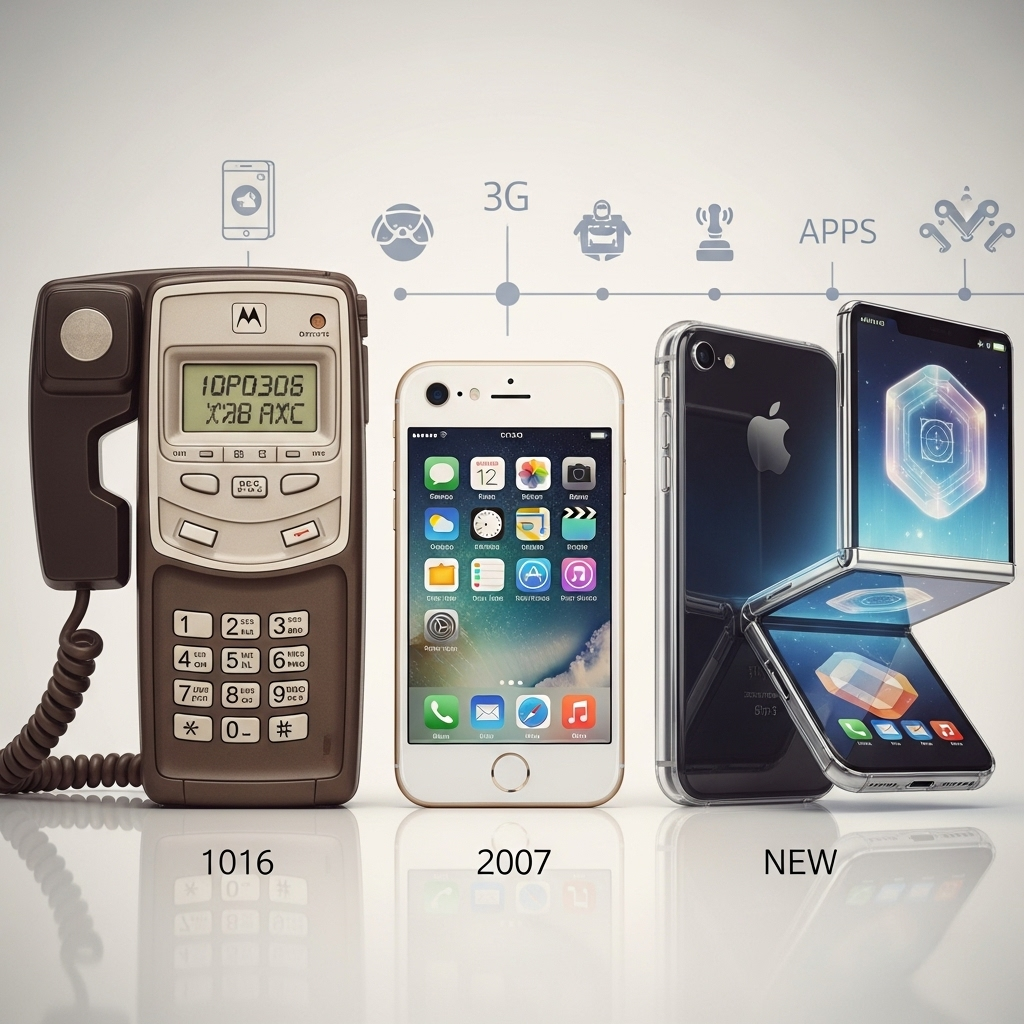From Clunky Beginnings to Pocket Powerhouses
The journey of mobile technology reads like a sci-fi novel turned reality. What began with the IBM Simon in 1992—a 1.1-pound “brick” with a monochrome touchscreen and basic email capabilities—has evolved into today’s AI-powered supercomputers that fit comfortably in our palms. Early mobile devices were glorified digital Rolodexes and calculators with SMS capabilities that felt revolutionary at the time. Each character cost precious cents, and receiving a text notification was an event worthy of celebration. These limitations shaped an era where mobile was an afterthought in business strategy, merely an extension of desktop computing rather than a primary engagement channel.
Fast forward to 2024, and mobile technology has shattered its utilitarian origins to become the central nervous system of modern commerce and communication. Smartphones now leverage unprecedented capabilities: 5G networks enabling near-instant data transfer, sophisticated GPS systems powering location-based marketing, and embedded AI that anticipates user needs before they’re articulated. According to Martech Zone, today’s mobile apps have morphed from simple tools into “pocket-sized powerhouses driving industries, transforming marketing, and revolutionizing sales” in ways that would have seemed like fantasy just two decades ago. This seismic shift hasn’t just changed how we interact with technology—it’s rewritten the rules of consumer engagement and business strategy.

The Smartphone Revolution: Catalyst for Business Transformation
The launch of Apple’s iPhone in 2007 wasn’t just a product release—it was the detonation of a business paradigm bomb. Suddenly, businesses faced an unprecedented opportunity: connecting with customers in intimate, context-aware ways through a device that spent more time in users’ hands than wallets. The introduction of the App Store two years later created an entirely new economic ecosystem, transforming smartphones from communication devices into customizable business platforms. Enterprises quickly recognized that mobile wasn’t merely another channel but the primary touchpoint where brand experiences were made or broken.
This shift necessitated fundamental changes in organizational structure and strategy. Marketing departments evolved from channel-focused silos to integrated growth teams where mobile experience dictated website design, customer journey mapping, and even physical store layouts. As BoostenX highlights, what began as rudimentary SMS marketing has “evolved into a sophisticated ecosystem where brands can engage audiences through a variety of mobile channels, including apps, social media, and in-app experiences.” With over 6.8 billion smartphone users globally each spending 4–5 hours daily on mobile devices, businesses that fail to prioritize mobile-first strategies operate at an existential disadvantage. The statistics are unequivocal: mobile isn’t just important—it’s become the defining medium of modern commerce.
The Mobile Marketing Explosion: Precision Engagement at Scale
Today’s mobile marketing landscape bears little resemblance to the early days of banner ads and intrusive pop-ups. Modern platforms like Google Ads and Facebook Ads provide surgical targeting capabilities based on hyper-specific location data, real-time behavior, and predictive analytics. EOXS reports that this precision enables businesses to “reach their ideal audience more effectively than traditional advertising methods,” with mobile advertising now accounting for over 70% of digital ad spending globally. The days of spraying generic messages to broad demographics are over; today’s mobile marketing delivers personalized experiences that feel less like advertising and more like valuable assistance.
This evolution has birthed entirely new engagement paradigms:
- Contextual messaging: Delivering weather-appropriate product suggestions when users enter specific geofenced areas
- Progressive web apps: Offering near-native experiences without requiring app store downloads
- Augmented reality try-ons: Allowing virtual product testing through smartphone cameras
- Voice commerce integration: Enabling purchases through voice assistants during natural interactions
As mobile commerce continues its meteoric rise—now representing over 50% of all e-commerce sales according to EOXS—the most successful brands treat their mobile experience not as a sales channel but as the central hub of their entire customer relationship. The companies thriving in this landscape understand that frictionless mobile experiences have transitioned from competitive advantage to basic expectation.
Pro Tip: The Invisible Funnel
While most marketers focus on visible conversion points, the most sophisticated mobile strategies optimize for what I call “the invisible funnel”—those micro-interactions that happen between major touchpoints. Track how users interact with your push notifications, how long they linger on specific app screens, and which features get abandoned mid-process. These subtle behavioral signals often reveal more about purchase intent than traditional metrics. Tools like Firebase Analytics or Mixpanel can help decode this hidden journey, allowing you to optimize experiences at the precise moments that determine whether mobile users convert or churn.
Mobile Technology’s Business Impact: Redefining Sales and Operations
Mobile technology has fundamentally rewritten sales methodologies, transforming what was once a field-dependent, paper-driven process into a dynamic, data-rich engagement engine. Modern sales teams leverage CRM integrations directly within mobile workflows, accessing real-time inventory data, processing payments on the spot, and sending instant follow-ups—all from devices that fit in a jacket pocket. The EOXS report emphasizes how location-based targeting allows sales teams to “engage users in a non-intrusive manner” through in-app advertising, resulting in engagement rates far surpassing traditional display ads. More significantly, mobile has democratized sales enablement—what once required specialized technical teams can now be executed by frontline staff with intuitive mobile interfaces.
Beyond sales, mobile technology has revolutionized operational efficiency across departments:
| Business Function | Pre-Mobile Reality | Current Mobile Capabilities |
|---|---|---|
| Customer Service | Call center wait times exceeding 30 minutes | Instant AR-powered troubleshooting via smartphone camera |
| Field Operations | Paper work orders with 48-hour processing delays | Real-time job tracking with automated parts ordering |
| Inventory Management | Manual stock counts causing 15-20% inaccuracies | RFID scanning with instant system updates |
| Marketing Campaigns | Print catalogs with 2-3% response rates | Hyper-personalized push campaigns with 25%+ engagement |
This operational transformation extends to business intelligence, where mobile dashboards provide executives with real-time performance metrics accessible anywhere. No longer tethered to desktop terminals, decision-makers can respond to market shifts with unprecedented speed—turning what was once “management by walking around” into “management by knowing everything, anywhere.”
Future Horizons: What’s Next in Mobile Evolution
The mobile technology narrative continues accelerating toward even more transformative territory. Current innovations point toward three converging trajectories:
1. The Seamless Ambient Interface – Moving beyond screen-based interactions toward contextual computing where devices anticipate needs before explicit commands. As AppsRhino notes, the pace of mobile evolution means “what was once famous five years ago has now been replaced by something completely different,” suggesting ambient intelligence will become the next standard.
2. The Physical-Digital Convergence – Through advanced AR and spatial computing, mobile devices are becoming windows into blended realities where digital information overlays physical environments. Imagine pointing your phone at a storefront to see real-time inventory, or viewing historical data overlaid on city landmarks during a walking tour.
3. The Privacy-Powered Ecosystem – With declining third-party cookie reliance and stricter privacy regulations, the next mobile evolution centers on first-party data strategies that deliver personalization without intrusion. Apple’s App Tracking Transparency framework has already forced a fundamental shift toward contextual marketing that respects user privacy while maintaining effectiveness.
As New Tech Society observes, mobile technology has evolved from simple communication tools into a “living, breathing phenomenon that’s reshaping the way we connect, work, and play.” The future won’t just be about better devices—it will be about more meaningful connections between technology and human behavior. The most successful businesses will recognize that mobile’s ultimate evolution is toward becoming an invisible, indispensable extension of human capability.
Pro Tip: Future-Proof Your Mobile Strategy
Rather than chasing the latest mobile trend, build adaptability into your core strategy. Implement these three future-proofing tactics:
- Modular Architecture: Design your mobile ecosystem using interchangeable components that can be updated independently (e.g., separate payment processing from UX layers)
- Friction Inventory: Document every interaction point where users experience hesitation, then prioritize eliminating those barriers before adding new features
- Behavioral Agility: Create rapid testing protocols for emerging interaction models (voice, gesture, glance-based) so you can deploy them within weeks rather than months
The brands that thrive won’t be those with the shiniest new features, but those that master the art of continuous mobile adaptation.
The Imperative for Modern Businesses: Mobile-First Mindsets
The most significant shift in mobile technology’s evolution isn’t technical—it’s psychological. Forward-thinking organizations have moved beyond “mobile-friendly” thinking to embrace genuinely mobile-native approaches where desktop experiences are derived from mobile rather than the reverse. This fundamental mindset shift recognizes that approximately 60% of global internet traffic now originates from mobile devices, with users increasingly abandoning sites that don’t load instantly or require pinch-zooming to navigate.
Successful brands treat mobile as both a channel and a strategic lens through which all customer experiences should be evaluated. Consider these mindset shifts separating industry leaders from laggards:
“Businesses that still treat mobile as ‘just another channel’ are operating with a 2010-era playbook. Mobile today is the customer experience—it’s where discovery happens, research occurs, and purchase decisions crystallize.” – Marketing Director at Global Tech Firm
These leaders understand that mobile excellence requires breaking down organizational silos. Marketing, sales, IT, and customer service must align around mobile experience metrics rather than channel-specific KPIs. The companies achieving remarkable results have dissolved artificial boundaries between “mobile team” and “web team,” creating unified growth squads focused exclusively on customer journey optimization across all touchpoints.
Implementing Your Mobile Evolution Strategy: Actionable Framework
Building a world-class mobile presence requires more than reactive tactics—it demands a strategic framework designed for continuous evolution. Based on our experience guiding Fortune 500 companies through mobile transformation, we’ve distilled the process into five essential pillars:
1. The Mobile Maturity Assessment
Evaluate your current mobile capability across six dimensions:
- Technical infrastructure
- Organizational alignment
- Data utilization
- Customer experience
- Monetization strategy
- Innovation pipeline
2. The Experience Acceleration Engine
Create a dedicated process for rapid mobile optimization:
- Implement always-on A/B testing for key flows
- Establish quantifiable friction metrics (e.g., “taps to purchase”)
- Build cross-functional rapid response teams
3. The Predictive Engagement Layer
Move beyond reactive marketing with these capabilities:
- Real-time behavior-triggered messaging
- Predictive inventory allocation based on mobile search trends
- Context-aware content personalization
Your mobile evolution roadmap should operate on three time horizons simultaneously: optimizing today’s experiences (0-6 months), implementing emerging capabilities (6-18 months), and preparing for disruptive shifts (18+ months). The most successful programs allocate resources across all three horizons rather than focusing exclusively on immediate ROI.
Conclusion: Embracing the Mobile Imperative
Mobile technology’s evolution from communication accessory to business central nervous system represents one of the most profound shifts in commercial history. As AppsRhino wisely notes, “futurists and academics believe that technology, particularly mobile apps, will continue to evolve based on historical tendencies”—but for today’s marketers, the future is already here. The brands thriving in this environment recognize that mobile isn’t about devices or channels; it’s about meeting customers in the context of their lives with precisely the right value at exactly the right moment.
The statistics tell an undeniable story: with 6.8 billion smartphone users globally spending significant portions of their day on mobile devices, this platform has become the primary interface between businesses and customers. Companies that relegate mobile to “just another channel” do so at their peril, while those embracing mobile-native thinking are rewriting industry rules and capturing disproportionate market share.
Your journey begins not with technology choices but with mindset shifts. Stop asking “How can we make this mobile-friendly?” and start demanding “How would this work if mobile was the ONLY touchpoint?” This fundamental reframing sparks the innovation that separates industry leaders from followers in today’s mobile-dominant landscape. The evolution continues—will your business lead the next chapter or struggle to catch up?
